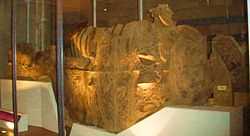Scolosaurus
| Scolosaurus Temporal range: Late Cretaceous, 76.5Ma | |
|---|---|
 | |
| Type specimen at Natural History Museum, London | |
| Scientific classification | |
| Kingdom: | Animalia |
| Phylum: | Chordata |
| Clade: | Dinosauria |
| Order: | †Ornithischia |
| Family: | †Ankylosauridae |
| Subfamily: | †Ankylosaurinae |
| Genus: | †Scolosaurus Nopcsa, 1928 |
| Type species | |
| †Scolosaurus cutleri Nopcsa, 1928 | |
Scolosaurus is an extinct genus of ankylosaurid dinosaurs within the subfamily Ankylosaurinae. It is known from the lower levels of the Late Cretaceous Dinosaur Park Formation (latest middle Campanian stage, about 76.5 Ma ago) of Alberta, Canada. It contains a single species, Scolosaurus cutleri.[1]

Scolosaurus was named by Franz Nopcsa von Felső-Szilvás in 1928, based on holotype NHMUK R.5161, a partial postcranial skeleton. The skeleton was collected by William Edmund Cutler in 1914 from Royal Tyrrell Museum of Palaeontology Quarry 80 at Deadlodge Canyon.[1][2] It was collected from the bottom of the Dinosaur Park Formation or possibly even from the uppermost layers of the underlying Oldman Formation, making it the oldest described North American ankylosaurid.[3] The generic name is derived from σκῶλος, skolos, "pointed stake", and sauros, "lizard" in Ancient Greek.[4] The specific name, cutleri, honours its discoverer and the collector of the holotype, W. E. Cutler,[2] who was seriously injured when the specimen fell on him as he was excavating it.[5]
In 1971, Walter Coombs concluded that there was only one species of ankylosaurid during the Campanian age of the Late Cretaceous of North America. He synonymised the species Anodontosaurus lambei, Dyoplosaurus acutosquameus, and Scolosaurus cutleri with Euoplocephalus tutus.[6] The synonymisation of Scolosaurus cutleri and Euoplocephalus tutus was generally accepted and thus NHMUK R.5161 was assigned to E. tutus. However, a redescription of Scolosaurus published in 2013 in the Canadian Journal of Earth Sciences by Paul Penkalski and William T. Blows suggested that the genus is a valid taxon. They concluded that Scolosaurus can be distinguished from Euoplocephalus by the form of their cervical armor, details of other armour, and the structure of the forelimb. They also found that Scolosaurus and Dyoplosaurus are distinct, due to differences in the pelvis and armour.[1]
A 2013 study found Oohkotokia to be indistinguishable from Scolosaurus, and therefore a junior synonym.[7]
Due to its completeness, the holotype of Scolosaurus has formed the basis for most Euoplocephalus reconstructions since 1971; therefore, most images of Euoplocephalus actually depict Scolosaurus instead.
References
- ↑ 1.0 1.1 1.2 Penkalski, P.; Blows, W. T. (2013). "Scolosaurus cutleri (Ornithischia: Ankylosauria) from the Upper Cretaceous Dinosaur Park Formation of Alberta, Canada". Canadian Journal of Earth Sciences: 130110052638009. doi:10.1139/cjes-2012-0098.
- ↑ 2.0 2.1 B. F. Nopcsa (1928) "Palaeontological notes on reptiles. V. On the skull of the Upper Cretaceous dinosaur Euoplocephalus." Geologica Hungarica, Series Palaeontologica 1(1):1-84
- ↑ Penkalski, P. (2013). "A new ankylosaurid from the late Cretaceous Two Medicine Formation of Montana, USA". Acta Palaeontologica Polonica. doi:10.4202/app.2012.0125.
- ↑ Liddell, Henry George and Robert Scott (1980). A Greek-English Lexicon (Abridged Edition). United Kingdom: Oxford University Press. pp. 630, 640. ISBN 0-19-910207-4.
- ↑ Tanke, Darren H. (2010). "Lost in plain sight: Rediscovery of William E. Cutler's lost Eoceratops". In M.J. Ryan, B.J. Chinnery-Allgeier, D.A. Eberth. New perspectives on horned dinosaurs: The Royal Tyrrell Museum ceratopsian symposium. Bloomington: Indiana University Press. pp. 541–50. ISBN 978-0-253-35358-0.
- ↑ Coombs W. (1971) The Ankylosauridae. Ph.D. thesis, Columbia University, New York, NY, 487 p.
- ↑ Arbour, V. M.; Currie, P. J. (2013). "Euoplocephalus tutus and the Diversity of Ankylosaurid Dinosaurs in the Late Cretaceous of Alberta, Canada, and Montana, USA". In Farke, Andrew A. PLoS ONE 8 (5): e62421. doi:10.1371/journal.pone.0062421.